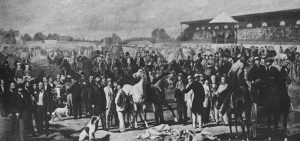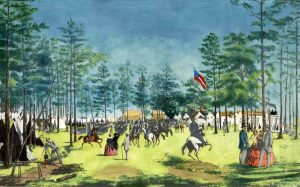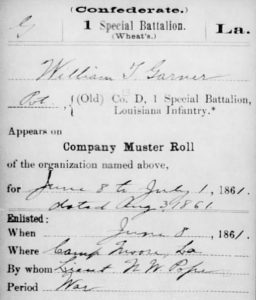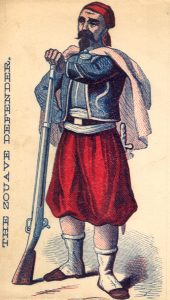“Were you ever at Camp Moore?” – Louisiana’s Largest Training Camp – Part I
Emerging Civil War welcomes back guest author Sheritta Bitikofer…
Part I of II…see Part II here
Nestled deep in the woods of St. Helena Parish, along the New Orleans & Jackson Railroad, seventy-five miles north of the famous Crescent City, and near the town of Tangipahoa, Louisiana, sits what remains of the largest Confederate training camp in the western theatre during the Civil War.

For many Louisiana soldiers, the story did not start in Tangipahoa. In the spring of 1861, it became more and more evident that volunteer soldiers who were awaiting muster into the Confederate army needed a centralized place to gather and train. Camp Walker was first established in early May at the old Metairie Race Course in New Orleans. However, conditions here were less than ideal. Poor drinking water, incessant mosquitoes, and swampy ground tormented recruits until a new site could be found. Orders were handed down to General Elisha L. Tracy to begin moving his troops from Camp Walker to the newly established Camp Moore.[1]
Named after Governor Thomas Moore, Camp Moore became the center for all troop movements in and out of New Orleans. This new piece of ground was more than ideal for the recruits. The spacious pine forest was situated on level, but high ground, which solved their mud and drainage problem. Transportation became a breeze with the easy access to the railroad that shuttled troops and supplies to and from the camp. Mosquitoes, too, were practically non-existent, making Camp Moore almost like a paradise compared to their previous location at Camp Walker. On May 17th, John Austen, a private with the 4th Louisiana Infantry, wrote, “We have plenty of shade, so much so that the companies, as they arrive, are compelled to clear the ground in order to pitch their tents. A large space also had to be cleared to secure an ample parade ground and drill ground. The water is excellent for drinking, bathing and cooking purposes; the Tangipahoa River passing near us on the east, and Beaver Creek bounding the camp on the west.”[2]

Within a short span of time, Camp Moore was up and running. Newly enlisted troops from Louisiana and its surrounding states were sent to Camp Moore for training prior to their deployment with their regiments across the country. The New Orleans Bee reported on one visit to the camp there being, “buildings of the quartermaster and commissary departments, the tents of headquarters, the sutler’s sheds, the little booths of stores and refreshments, the guard house, a log cabin covered over with evergreens, and the shanty of an enterprising ambrotype artist who furnishes handsome warriors with their ‘counterfeit presentments’.”[3]
They came from all walks of life and nationalities – as New Orleans was a melting pot of ethnicities. Rough “wharf rats” would mix with sons of planters. Native-born English and Irish immigrants would struggle to communicate with their German and French messmates. Companies, often formed by the parishes they hailed from, gave themselves names like “Orleans Rifles”, “Shreveport Rangers”, “Catahoula Guerillas”, and “Claiborne Guards”. It is impossible to mention Louisiana without giving a special mention to the regiments of Zouaves, or Major Chatham Roberdeau Wheat’s infamous Louisiana Tiger Battalion that also mustered out of Camp Moore. There, they swore allegiance to Louisiana and to the Confederacy. [4]

From four in the morning until nine in the evening, men prepared for life as a soldier in the Confederate army.[5] While learning to shoot and drill, the men also learned how to take care of themselves while in camp. Aristide Guillory of the 8th Louisiana, Company F, wrote during his first month at Camp Moore, “At first, some of the boys were rather dissatisfied with the condition of things in camp. The idea of washing shirts and ironing them with a brick bat, grinding coffee and washing dishes was rather undesirable, but actual necessity has taught them not to flinch from any duty, no matter how unpleasant it may be, and all are perfectly reconciled to do whatever may devolved upon them.”[6]
While Camp Moore received mixed reviews from its soldiers, John Marker zealously wrote home saying, “Were you ever at Camp Moore! It is a beautiful place. The place of encampment is about fifty acres of level pine land surrounded by these beautiful streams of water as clear as it can be and as cold as water ever gets to be. Any body to look at the place and water would say in an instant this is a healthy place.”[7} William Trahern also said of Camp Moore, “It seemed to me to be too beautiful a spot to make use of, for the purpose of training men to kill their fellow-man.”[8] Not all enjoyed their time at the camp. Al Pierson wrote home, “The camp is one of the filthiest places I have ever been permitted to see. There are more flies in and around Camp Moore than there are in all Bienville Parish.” [9] Political subterfuge and corruption also plagued the regiments and companies who voted for their commanding officers while at Camp Moore.
However, as many Civil War historians know, the troops that came out of Louisiana were not renowned for their discipline. Drunkenness and rowdiness were a constant problem within the borders of Camp Moore. Wit Martin wrote on June 4th, “We are encamped next to Maj Bob Wheat’s Battalion and a rough set of neighbors they are. One company is composed of levee rats of New Orleans and they have a row among themselves nearly every day. The whole camp has been under arms twice since we have been here to put down their rows but we have not been obliged to whip them in.” [10]
Part of this problem was due to the abundant supply of whiskey and alcohol that went almost unregulated. Sutlers and restaurants could be found within camp. Enlisted men flocked to these establishments and presented a written order from a commanding officer to acquire liquor. To trick the system, they forged signatures or fabricated names that were often overlooked by the sutlers. And if that did not work, there were several stores a mile away in Tangipahoa that could help them quench their thirst. [11] Discipline did exist within the camp. A private who was court-marshalled for striking at a commanding officer “was sentenced to wear a ball and chain for six weeks. During the first week he stood at evening parade on a post in public view; the next week he was to promenade with a barrel over his head.” [12]

Rations of beef, “some species of dried sausage, fried ham and tolerably good coffee” were served twice daily. [13] Enlisted men did endeavor to supplement their diets by going to the various restaurants on the western border of the camp. One restaurant within camp, affectionately called “Aunty’s” was operated by a “round and powerful hostess”. [14] Also, civilians and women were not barred from the camp. Families traveled from New Orleans along the railroad to visit their loved ones. The Daily True Delta reported, “The visitors to Camp More, and they are legion, are greatly amused by the fancy names with which most of the tents are inscribed, ‘Our Woodland Home’ is found in close proximity with ‘The Lion’s Den’ and ‘Happy Retreat’ with ‘Blood and Thunder’.”[15]
As with any Civil War encampment, the close confinement and poor sanitation created problems that their knowledge of medicine could not help. Two measles epidemics – one in 1861 and the other in 1862 – claimed the lives of countless enlisted men. In September of 1861, one soldier wrote about his departure from Camp Moore, “Without regret, we bade farewell to the old camp in the pines, with its six or seven hundred graves, containing the remains of Louisianans who had yielded up their patriotic young lives without having once faced the enemies of their beloved South.”[16] Thomas Harp of the 17th Louisiana, Company G, wrote to his mother on October 16, 1861, “I drop you a few lines with regret. I have to say to you in pain Brother is no more. He died this morning of Typhoid pneumonia. He was taken the 12th of this month. He had a chill when taken and he suffered with a pain in the breast and side. He got very near clear of the pain but seemed restless. He had all the attention the Camp could afford. A very good doctor attended him. He was willing to die in his last moments.”[17]

In the time it was active, as many as 35,000 men who were destined for Virginia and Tennessee marched through the parade grounds and were drilled to exhaustion along the New Orleans & Jackson Railroad. The newly enlisted men who boarded the trains at Camp Moore could not have known what awaited them on the front lines. Whether wounded, killed, or captured, their journeys often began at Camp Moore.
Stop back tomorrow for Part II….
————
Citations:
[1] United States. War Department. The War Of the Rebellion: A Compilation of the Official Records of the Union and Confederate Armies; Volume LIII, page 679-680. Washington :[s.n.], 1894.
[2] John Austen May 17 1861 – Pvt., Corpl. 4th La. Infantry – Bayou Sara Ledger, 8 June 1861
[3] New Orleans Bee, May 31, 1861
[4] Jones, Terry L. “Lee’s Tigers Revisited: the Louisiana Infantry in the Army of Northern Virginia.” Baton Rouge, LA: Louisiana State University Press, 2017.
[5] E. P. Ellis and Family Papers, Mss. 663, Louisiana and Lower Mississippi Valley Collections, LSU Libraries, Baton Rouge, La.
[6] Aristide Guillory June 1861 – Pvt. Co. F, 8th La. Infantry – Camp Moore Archives
[7] John Marker Sep 22 1861 – Benson Family papers, LSU Special Collections, Hill Memorial Library, LSU, Baton Rouge, LA
[8] Rubin A Pierson, June 1861 – “Lee’s Tigers”, page 13-14
[9] William E. Trahern, “A Biography of William E. Trahern, Witten September 21, 1926”, page 17, Richmond National Battlefield Park
[10] Wit Martin June 4th 1861 – Martin-Pugh Collection #231, Ellender Memorial Library, Nicholls State University, Thibodaux, LA
[11] John Mcgrath, “In a Louisiana Regiment,” Southern Historical Society Papers, XXXI (1903), pages 109-12
[12] Charles James Johnson Papers, Mss. 1152. Louisiana and Lower Mississippi Valley Collections, LSU Libraries, Baton Rouge, La. – 2nd Lt. Co. I, 11th La. Inf
[13] Lawrence Nicholls June 3rd, 1861 – 1st Lt. Capt. Co. K, 8th La. Inf – Nicholls Papers, Special Collections, Howard Tilton Memorial Library, Tulane University, New Orleans, LA
[14] Thomas Bellow Sept 17th, 1861 – Pvt. Co. E. 19th La. Infantry – Le Meschacebe newspaper on Microfilm at LSU Library, Baton Rouge, LA
[15] Daily True Delta, June 4th, 1861
[16] John Mcgrath, “In a Louisiana Regiment,” Southern Historical Society Papers, XXXI (1903), loc. Cit. pages 112
[17] Thomas Y. Harp to Mother, Oct 16th, 1861 – Pvt. Corpl. Co. G, 17th La. Inf – Regarding brother D. C. Harp, Pvt. Co. G, 17th La. Inf. En. Sept. 30, 1861, Camp Moore. Roll for Sept. to Nov. 1, 1861, Died Oct. 16, 1861.
Over the Thanksgiving holiday I’ll be in Louisiana and I’m going to drive out to Camp Moore. I’ve never been. I might even try to get to Vicksburg too. Nice time to be outdoors in Louisiana.
If you manage to go the weekend before, they have a living history demonstration. Usually the museum starts to shut down for the winter on Thanksgiving weekend, but you can still walk the grounds. And if you ask nicely, they may let you in to take a look around or watch the video presentation on Camp Moore in the lower level of the museum.
I might can make it the weekend before. Will look up the event.
Also, it is located in Tangipahoa Parish, just outside of St. Helena Parish. Just FYI. And not far from Brittney Spears hometown of Kentwood, Louisiana.
I’ll have to see if the parish boundaries changed between then and now. My resources said that Camp Moore was within St. Helena parish.
I didn’t even think about that. That could be correct. The parish boundaries might have changed.
So it was in St. Helena Parish in 1860. Modern Tangipahoa was created from parts of St. Helena, Livingston, St. Tammany, and Washington Parishes in 1869. I knew a bunch of Parishes were created postbellum but didn’t know that about Tangipahoa. Interesting.
Made it out there today. Saw a bit of the 2pm skirmish. Forgot how loud cannons can be. I was surprised by the number of people there. There parking area was full. For better or worse not a lot people seemed to afraid of Covid.
The museum is a little dated and kitschy, but if you are into Louisiana Confederates there is a lot to look at. I had never seen a photo of Davidson Penn before and they have a photo of Preston Pond as well, which I had only recently seen put online. It definitely hasn’t fully moved on from the Lost Cause, I think, but whatever… they’re keeping the location monumentalized and protecting the cemetery. I bought Terry Jones’ Lee’s Tigers Revisited from their small selection of history books. I read the original work over and over as a kid.
Afterwards, I drove over to the Old Jackson cemetery and finally located Col. Preston Pond’s (commanded a brigade at Shiloh) gravesite. His headstone, which must have been put up in 1863 has now broken off its base and lies on the ground. Overtime it is going to sink into the ground. It’s doing so already.
There is an old civil war hospital in the town of Tangipahoa at 12635 W. Claborne St. connects to hi-way 51 & there was a Dr. Tate there at the time. I have picture of him & his wife on the porch during the war.
I have a Photo I found of what I assume is my great great great something and its Signed and has inscription of “Camp Moore La Aug 18th 1861” in uniform holding a rifle. George Thomas I don’t know for sure what his fate ended up being but hes likely not still alive.
My great, great, grandad, 1st Sgt. Andrew Jackcon Pratt enlisted in May or June of 1861. He was with the Brush Valley Gusrds of the 9th Inf. La. He died of dysentry in August 1861 at Camp Bienville not too far from Centreville, Va. wish i could find his grave